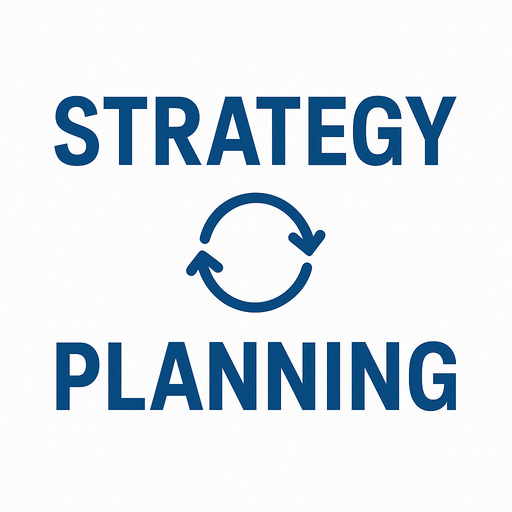 I often hear people debating: What's the difference between strategy and planning? Should we even talk about “strategic planning”?
I often hear people debating: What's the difference between strategy and planning? Should we even talk about “strategic planning”?
Whilst this debate can be interesting, I find much of it to be unhelpful.
In this article, I will argue that whilst we can try to distinguish between strategy and planning in theory, in practice, they are the same thing.
Strategy vs Planning: What’s the Difference?
People try to distinguish between strategy and planning using tables like this:
| Strategy | Planning | |
| Purpose | Decide what matters most | Operationalise what matters most |
| Key Question | “What should we do, and why?” | “How do we get it done?” |
| Time Horizon | Long-term, directional | Short- to medium-term, executable |
| Nature | Adaptive, conceptual | Structured, procedural |
| Focus | Positioning, trade-offs, advantage | Resources, timing, coordination |
Strategy is about choosing where and how to compete.
Planning is about turning that intent into coordinated action.
However, in practice, it becomes much more difficult to distinguish between them.
- How do you operationalise what matters most without first deciding what matters most?
- What happens when what you thought mattered most turns out to be unexpectedly difficult to operationalise?
- What's really the difference between what we do and how we do it?
- What about short-term strategies and long-term plans?
- Why can't plans be adaptive and conceptual?
- What is an unresourced or uncoordinated positioning, trade-off or advantage which is devoid of timing?
The Oxford English Dictionary highlights the apparent contradiction in trying too hard to separate the terms. It defines:
- "strategy" as a plan of action or a general plan designed to achieve a major or overall aim, and
- "plan" as a detailed scheme, method, or arrangement for achieving a particular aim or purpose.
The definitions are more similar than different! Perhaps the proponents of a clear separation between the two are looking for or creating differences that don't need to be there. After all, the table above is made up to support the argument for distinction more than it is inherent in the meaning of the words themselves. It reflects a choice or choices someone has made. Who is to say they are right?
But, let's assume for the moment that strategy and planning are somehow different. You still need both. And you need to integrate them.
Strategy AND Planning: Why you need both
Strategy needs planning. And planning needs strategy.
So, whilst trying to distinguish between the two may be academically interesting, it is not practically helpful.
Strategy and Planning are Inseparable.
Here is why.
One without the other is useless:
- A strategy without a plan that delivers it is merely a vain hope.
- A plan without a strategy to guide it is merely busy work.
You need both. Moreover, you need them to align.
Strategy and Planning must be Aligned
If your strategy says one thing—e.g., “We’re going to differentiate through innovation”—but your plan says another—e.g., “We’re cutting R&D and prioritising efficiency”—then:
-
Either the strategy is hollow (not backed by action),
-
Or the plan is misguided (ignores strategic intent).
If your strategy says one thing and your plan says another, then either one or the other won’t get done. Either way, you won’t get what you say you want.
Planning Shapes Strategy as much as Strategy Shapes Planning
It's tempting to think that Strategy Shapes planning and that we should therefore do Strategy first and then Planning second. However:
-
Planning reveals constraints that challenge strategic assumptions
-
Operational realities surface during planning that reshape strategic direction
-
Cross-functional engagement in planning highlights gaps in capabilities, coordination, or incentives
-
Scenario planning and modelling expose fragility in strategy and encourage robust design
In short, planning is not just downstream of strategy—it’s a feedback loop that refines and tests strategic choices.
Strategy and Planning must happen together
Doing strategy without planning is as useless as doing planning without strategy. Furthermore, the two have to be done in an integrated manner for either of them to be done well. The sensible solution is to combine and integrate the two.
We usually call this Strategic Planning.
Strategic Planning: Integrating Strategy and Planning
❌ Strategic Planning does have a bad name
Unfortunately, strategic planning has developed a bit of a bad name.
In many organisations, strategic planning has become synonymous with producing a lengthy document full of charts, forecasts, and goals—but lacking true strategic insight. This leads to:
-
Plans that don’t make real choices
-
Strategies that aren’t resourced or actionable
-
Confused teams and misaligned execution
-
Misalignment creates strategic drift, where the organisation says one thing but does another.
-
Strategic drift leads to underperformance or even outright failure.
🤔 Is the Problem Really with "Strategic Planning"?
Many critics argue that “strategic planning shouldn’t be a thing.” But what they’re really opposing is doing it badly, especially when:
-
It becomes an annual bureaucratic ritual
-
It avoids difficult trade-offs
-
It focuses on continuity, not advantage
-
It’s disconnected from execution
The problem isn’t the concept of strategic planning—it’s the quality of the process.
The thing is, anything can be done badly. Our task is to do it well. Not to stop doing it.
Done well, strategic planning:
-
Is a disciplined dialogue about direction, priorities, resource allocation and timing.
-
Aligns vision and intent with execution and operations.
- Bridges long-, medium- and short-term considerations.
-
Ensures strategy lives in decisions, not just documents.
-
Aligns across functions and levels.
-
Creates confidence in both direction and delivery.
📌 Final Thought
Trying to distinguish between strategy and planning is interesting—to a point. But what we really need more than that is to integrate them in the form of strategic planning.
Instead of debating the difference between strategy and planning, let's focus on doing better strategic planning.
If you need help applying this in your practice, StratNav integrates all the tools and frameworks you need for integrated strategic planning in a single, online and collaborative environment.
- Try it for free at: https://www.stratnavapp.com
- Sign up for a free demo at: https://www.stratnavapp.com/demo
